Related Post:
![]()
While scanning my bookshelves for Big Books I have read, I also found six that I have already read but want to read again.
You’d think that once through a Big Book would be enough, but in fact Big Books contain so much that they almost always withstand a second—or even a third or fourth—reading. In fact, rereading a Big Book often produces even more enjoyment than a first reading because you don’t have to hurry through to find out what happens. Instead, you can take time to savor the writing and appreciate the author’s technique.
Here, then, in no particular order, are six Big Books that I will definitely reread.
Middlemarch by George Eliot
paperback, 848 pages
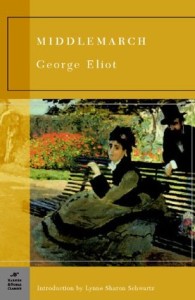 Serialized in 1871 and 1872 and published in a single volume in 1872, Middlemarch by George Eliot (pen name of Mary Ann Evans) portrays life in an English provincial town of the 1830s. The main character is Dorothea Brooke, an intellectual and idealistic woman who scholars say resembles the author in many ways. Brooke enters a disastrous marriage with a man she mistakes for her soul mate. In a parallel subplot, an idealistic young doctor, Tertius Lydgate, falls in love with a beautiful but superficial and vain woman, and these two also live an unpleasant married life.
Serialized in 1871 and 1872 and published in a single volume in 1872, Middlemarch by George Eliot (pen name of Mary Ann Evans) portrays life in an English provincial town of the 1830s. The main character is Dorothea Brooke, an intellectual and idealistic woman who scholars say resembles the author in many ways. Brooke enters a disastrous marriage with a man she mistakes for her soul mate. In a parallel subplot, an idealistic young doctor, Tertius Lydgate, falls in love with a beautiful but superficial and vain woman, and these two also live an unpleasant married life.
In this Big Book Eliot populates the town with characters of all social classes, including laborers and shopkeepers, members of the rising middle class, and people of the landed gentry. Goodreads describes this novel as “pivotal in the shaping of twentieth-century literary realism.”
The Corrections by Jonathan Franzen
hardcover, 568 pages
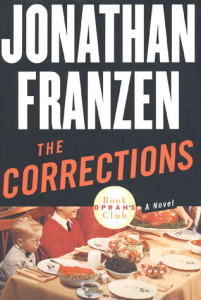 This Big Book by Jonathan Franzen won the 2001 National Book Award for fiction. The novel stands squarely in the canon of dysfunctional-family literature with its portrayal of the Lambert clan of St. Jude, a fictional midwestern city. Albert, the patriarch, has ruled the family with inflexible rules and plenty of rage for nearly 50 years. It’s no wonder that the three grown Lambert children have set out on their own mixed-up lives far from St. Jude.
This Big Book by Jonathan Franzen won the 2001 National Book Award for fiction. The novel stands squarely in the canon of dysfunctional-family literature with its portrayal of the Lambert clan of St. Jude, a fictional midwestern city. Albert, the patriarch, has ruled the family with inflexible rules and plenty of rage for nearly 50 years. It’s no wonder that the three grown Lambert children have set out on their own mixed-up lives far from St. Jude.
As the novel begins, Albert has recently received a diagnosis of Parkinson’s disease. His long-suffering and perpetually unhappy wife, Enid, has set her heart on having the entire family reunite for one last Christmas dinner at the family home. We get to know each of the Lambert offspring as they work their ways around making it back home for that final confrontation with the past. Despite the subject matter, Franzen manages to keep the narrative from becoming a slogging Big Drag with astute psychological characterization and just the right touch of irony and humor.
An Instance of the Fingerpost by Iain Pears
hardcover, 691 pages
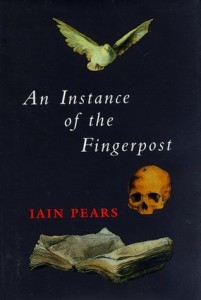 Set in England in 1663, An Instance of the Fingerpost tells the story of the murder of an Oxford don through the narratives of four different witnesses. The complex situation involves history, science, and cryptography in an effort to arrive at the truth of what happened. One of my book groups back in St. Louis read this not long after its publication in 1997, and everyone loved it.
Set in England in 1663, An Instance of the Fingerpost tells the story of the murder of an Oxford don through the narratives of four different witnesses. The complex situation involves history, science, and cryptography in an effort to arrive at the truth of what happened. One of my book groups back in St. Louis read this not long after its publication in 1997, and everyone loved it.
This Big Book was my introduction to the realization that there are as many sides to any story as there are participants. With its multiple narrators, it well illustrates the truth that some books are meant to be read more than once. Almost everyone in my book group said that, as soon as they finished reading it, they wanted to go back and read it all over again to appreciate how all the pieces of the story puzzle fit together. I’m embarrassed to say that I haven’t yet given this novel the rereading it so richly deserves. I should bump it up near the top of my reading list.
Bleak House by Charles Dickens
paperback, 887
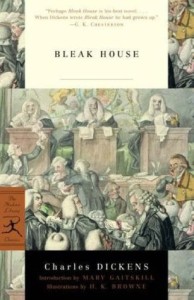 This novel, considered by many to be Dickens’ masterpiece, was first published in a single volume in 1853. It mixes satire, romance, and mystery in telling the story of Esther Summerson, a ward of John Jarndyce, as a seemingly never-ending lawsuit grinds its way through the huge, inefficient bureaucracy of the English legal process.
This novel, considered by many to be Dickens’ masterpiece, was first published in a single volume in 1853. It mixes satire, romance, and mystery in telling the story of Esther Summerson, a ward of John Jarndyce, as a seemingly never-ending lawsuit grinds its way through the huge, inefficient bureaucracy of the English legal process.
Really, this Big Book is a much better read than this description makes it sound.
The Poisonwood Bible by Barbara Kingsolver
paperback, 546
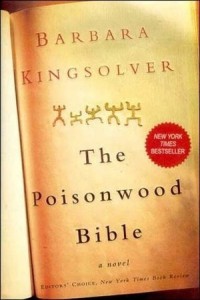 In 1959 Baptist preacher Nathan Price packs up his family, a wife and four daughters, and takes them from their home in Georgia to the Belgian Congo to spread The Word. Woefully inappropriately prepared, the family arrives in the midst of political upheaval. Price’s fire-and-brimstone form of Christianity along with his ignorance and arrogance soon alienate the local inhabitants even further. The first half of the novel deals with the family’s experiences in the Congo, while the latter half follows the family members’ lives for 30 years after they leave.
In 1959 Baptist preacher Nathan Price packs up his family, a wife and four daughters, and takes them from their home in Georgia to the Belgian Congo to spread The Word. Woefully inappropriately prepared, the family arrives in the midst of political upheaval. Price’s fire-and-brimstone form of Christianity along with his ignorance and arrogance soon alienate the local inhabitants even further. The first half of the novel deals with the family’s experiences in the Congo, while the latter half follows the family members’ lives for 30 years after they leave.
The most striking aspect of this Big Book is Kingsolver’s ability to create distinctive voices for each of the characters as they take turns narrating the story. This is the benchmark against which I evaluate all other novels that employ multiple narrators, an approach to fiction writing that is quickly becoming the norm.
Middlesex by Jeffrey Eugenides
paperback, 529 pages
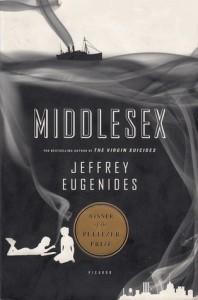 It takes a Big Book to tell a family’s history. Middlesex tells the story of three generations of the Greek-American Stephanides family as they leave a tiny village near Mount Olympus and travel to Detroit, where they live through Prohibition and then the 1967 race riots before moving to suburban Grosse Pointe.
It takes a Big Book to tell a family’s history. Middlesex tells the story of three generations of the Greek-American Stephanides family as they leave a tiny village near Mount Olympus and travel to Detroit, where they live through Prohibition and then the 1967 race riots before moving to suburban Grosse Pointe.
Throughout the story, the novel focuses on Calliope Stephanides as she searches for the reasons why she’s not like other girls. Gradually Callie becomes Cal while remaining a fascinating narrator whom the reader follows with delight.
© 2016 by Mary Daniels Brown

